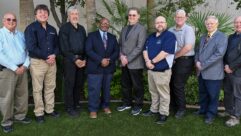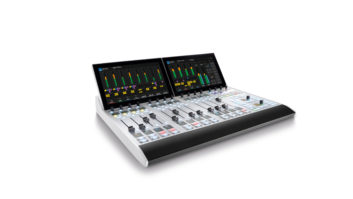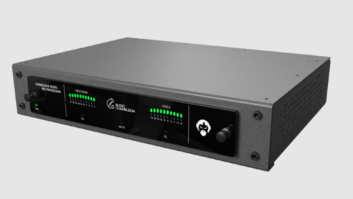This article originally appeared in TV Technology.
In this column, we’ll examine a topic I’ve been contemplating for awhile: large-format digital audio console surface design; the problems with it and why it may be time for a change. Most console surfaces remain similar to the classic design introduced in the 1970s, yet the back-end technology supporting them has changed dramatically.
The standard surface is still made up of a meter bridge, a section for controls and a fader area. Modern surfaces are really more like remote controls, with no actual audio inside them, while their fully digital cores do the real processing. Recently, several manufacturers have deviated from traditional surface design and given us a glimpse into the future of console surfaces.
LOOKING AT COST, EXPECTATIONS
Two primary reasons a redesign may be in order are the cost of the surfaces and changing user expectations. Large-format digital audio consoles with many channels, powerful DSP features and internal routers are expensive investments for any broadcaster. Live production consoles are now typically outfitted with between 300 to more than 1,000 inputs, with similar output counts. With new technology introductions like 4K and budgets tightening for all but the highest-profile shows, obtaining the capital to buy large consoles seems to be increasingly difficult.
Raven MTX from Slate Pro Audio
Manufacturers tell us the surface of large digital audio consoles is the most expensive part of the system, so it just makes sense to find ways to bring that cost down. Users are changing as well, with many younger mix engineers just as comfortable using mice, trackpads, touchscreens and other types of controllers as they are using faders and knobs.
I know some sound designers who have never mixed using real faders, but simply make adjustments in their workstation and use onscreen faders. Those same mixers have never had to mix a live sporting event, however, and the engineers currently mixing those shows still want faders.
There are other reasons to rethink surface design. Placing a large reflective surface between speakers and your ears creates a comb filter right at the mix position. Mount those speakers on the meter bridge and they couple to the console frame coloring the low mid-range of the mix. These problems are not new, but perhaps it’s time to think about changing surface design to eliminate them as factors in control rooms. Then again, most audio mix rooms now have so many device screens obstructing the soundfield that perhaps reflections from the surface are actually a minor issue in comparison.
Manufacturers have been releasing a few surfaces that differ from the status quo by using touchscreens, more screens and fewer physical controls. The surface with the most gratuitous use of glass (so far) is the Raven MTX from Slate Pro Audio. Designed for recording rather than broadcast, this surface is made up of a 27-inch industrial- grade touchscreen, running custom software that allows it to work with digital audio workstations. There is a small meter bridge on top and an armrest-style area under the screen with a keyboard, trackball, transport and monitor controls, but otherwise this thing is one great big screen.
After seeing this surface I wondered what kind of reflections would be caused by such a large piece of glass at the mix position, but Slate Pro Audio claims the 40-degree angle design minimizes comb filtering. The really intriguing thing about this surface is that it seems to handle multitouch extremely well, and all onscreen controls appear to respond as if they were physical ones. Making the touchscreen function as if the onscreen controls are real is essential for physical control replacement.
To my knowledge, no manufacturer in the broadcast world has introduced a large touchscreen surface to rival the Raven, but the Lawo mc²56, Wheatstone D-8EX, Calrec Callisto and SSL Live are all examples of broadcast and live production audio consoles where the surface is more compact; there are fewer physical controls; and screens dominate the surface.
While their surfaces still mostly conform to traditional layouts, all of these consoles have a considerable amount of space consumed by screens. The mc²56 and D8-EX utilize touchscreen controls for key functions, while the Callisto and Live are heavily touchscreen-dependent for operation. Since adding controls and customizing features for screens is just a matter of writing new code and doesn’t require new hardware, we’re likely to see much more screen real estate on console surfaces in the coming years.
INCREASED PRODUCTION DEMANDS
While tight budgets are one reason for reducing the cost of the surface, production demands are actually increasing, with directors and producers aiming to do whatever it takes to give their show an edge. This means more shoot locations, new playback devices and new graphics elements, all with accompanying sound. Since sources for surround broadcasts are six channels wide, the introduction of each new source can increase channel count needs quickly.
There is also the need for delivering content in multiple languages and the desire to provide surround mix minuses for archiving and rebroadcast, all produced live from the event site. Immersive audio and audio objects technologies for 4K production will bring even more sources, destinations and complications to the mix engineer’s job. Even if surface designs change, control, monitoring, routing and console connection needs are likely to increase and become more complex.
The design changes we’re seeing on some of the new console surfaces may indicate that manufacturers already realize the need to make them less costly, while retaining flexibility. With an up-and-coming generation of mix engineers who grew up playing video games, and the proliferation of touchscreens in the marketplace, the possibility to change how engineers use and interface with audio consoles may be here, but it’s critical that new surfaces not lose functionality in the process.
Mixing live television is an increasingly complex job and doing it successfully means having a console with the right degree of connectivity, functionality and control. As always, it’s important to have the right tool for the job, whether the controls are physical or virtual.
Jay Yeary has worked as a live mix engineer and sound designer and now spends his days working in the engineering department of a large media corporation.










